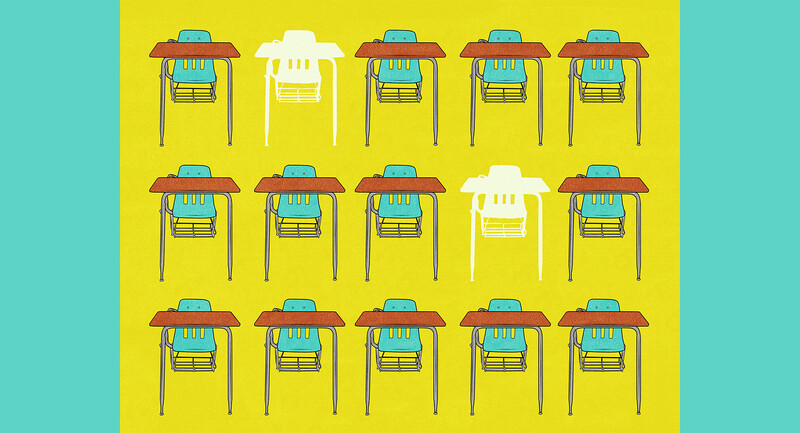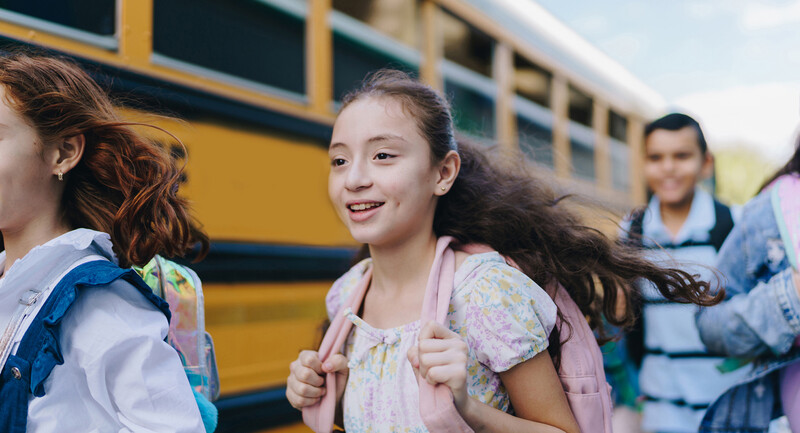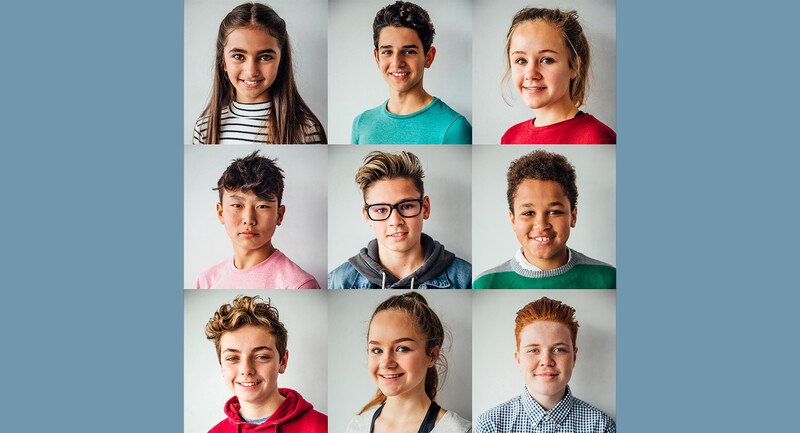Gifted students—you may or may not spot them in your classroom. They may be highly visible, like the high achievers or straight-A students. But they may also be among those students who don't finish their work (it's never perfect enough), who zone out or act out in class (they're bored), or who test poorly because they overthink things ("Hmmm, this answer might be true in this case, but it might not be true in that case").
Some schools and districts have substantial resources to identify and support giftedness, wherever it shows up. Some offer pull-out programs. Others offer cluster grouping, in which gifted students are grouped in specific classes at each grade level.
Dina Brulles, director of gifted education in the Paradise Valley Unified School District in Phoenix, Ariz., believes gifted students need less grade-level work, faster-paced lessons, deeper and more advanced content, and opportunities to work with other gifted students. They also require a different kind of interaction with the teacher, who must be less of a "sage on the stage" and more of a "guide on the side."
But First, the Big Picture
M. René Islas, executive director of the National Association for Gifted Children (NAGC), notes one persistent challenge to gifted education—a lack of uniformity in programming. A recent NAGC study found that 19 states don't monitor gifted programs at the local level, only seven require their districts to report on gifted student achievement, and fewer than half report on the race and ethnicity of their gifted students (minorities are significantly underrepresented in gifted programs, according to the U.S. Department of Education's Office of Civil Rights).
But there are promising signals as well, explains Islas. The Every Student Succeeds Act requires states and districts to track the progress of their highest-achieving students and allows schools to use Title I funds to identify and support gifted students. Plus, the law opens up the possibility for schools to use computer-adaptive assessments to recognize student mastery of content above grade level.
Then there are the challenges and opportunities at the school level. With the following strategies, teachers can tend to the complex needs of their high-ability students in the heterogeneous classroom.
1. Offer the Most Difficult First
"Gifted students don't need to do 25 problems in math when they can do the five most difficult first to demonstrate mastery," says Brulles. She offers this opportunity to all students, not just those identified as gifted. Students who successfully complete the five problems are excused from that night's homework. If classwork is involved, the teacher simply needs to have a few extension activities on hand—tasks that carry the concept to the next level—for students to work on quietly while others complete the regular assignment.
"Most Difficult First" is one manageable way for teachers to compact the curriculum for their high-ability students. With compacting, students get to "throw away" the part of the curriculum that they already know, while receiving full credit for those competencies. This frees up students to work on more challenging content.
2. Pre-Test for Volunteers
Let's say a teacher is teaching two-digit multiplication. He might do some direct instruction for 10 minutes, then offer students the end-of-chapter test, saying, "If you get 90 percent or higher, you won't have to do the homework or practice work. You'll have different work to do." According to Brulles, some gifted students will take this option, whereas others may decide, "I don't know this; I need the practice work." Again, as in Most Difficult First, this strategy requires having extension work for students who test out of the material.
3. Prepare to Take It Up
Susan Flores, a 2nd grade teacher in Paradise Valley, meets a range of student abilities by using the standard as her baseline. "My desk serves as a staging area. I have several piles of activities there that take a concept up or down."
For example, when the class is working on the distributive property in math, those "piles" might include differentiated worksheets, word problems, and task cards. Depending on how students grasp the concept, Flores can either reteach, offer practice, or enrich.
Flores also uses "choice boards." In math, she might offer nine ways that students can demonstrate learning of multiplication. "Students can [use] one of their iPad apps or create a game. They jump in where they want to jump in," she notes.
All students in Flores's class can choose whether they want to take their learning to the next level. "I don't say, 'Because you're gifted, you get choice, and because you're not gifted, you don't.'" Optional challenge work is available to anyone who wants to try it.
4. Speak to Student Interests
Janice Mak, a gifted cluster teacher and 7th and 8th grade STEM teacher in Paradise Valley, gives students a menu of options in her computer science class. After stu-dents learn the basics of programming—perhaps through an online course from Stanford University or work with Google CS First clubs—they work in teams to create a robot. Students choose the level of complexity, from designing dogs that bark to building miniature disco rooms in which a record plays and lights flash.
Students can also tailor a project to their interests. In a module on architecture, some students designed a playground for Egyptian students using Legos, Build with Chrome, or Minecraft. One student opted instead to recreate the White House using Minecraft.
The Ignite presentation format offers another way for Mak to differentiate work on the basis of student interest. The presenter has exactly 5 minutes and 20 slides, which auto-advance every 15 seconds, to discuss a topic of interest (aligned to the unit). This activity allows students to share their passion with their peers, be it nanotechnology and its role in medicine, the physics of roller coasters, or the latest advances in virtual reality.
According to education expert Jenny Grant Rankin, knowing a student's emotional intensities—what Polish psychologist Kazimierz Dabrowski called "overexcitabilities"—is also key to teaching gifted students. Dabrowski identified five areas of sensitivity that are strongly related to giftedness: psychomotor, sensual, intellectual, imaginational, and emotional.
Overexcitabilities will often appear as quirks, such as compulsive talking or organizing, heightened sensitivity to smells or tastes, insatiable curiosity, or daydreaming. Knowing a student's overexcitabilities can help teachers shape engaging—and personalized—learning experiences. An imaginational student will benefit from an assignment that he's free to complete in a unique way. An intellectual student will prefer to investigate why certain areas of the world struggle with starvation rather than simply listing those areas. Although we tend to see overexcitabilities negatively, they are often accompanied by great creativity, imagination, and drive.
5. Enable Gifted Students to Work Together
According to NAGC, research shows that enabling gifted students to work together in groups boosts their academic achievement and benefits other students in the classroom, as well. When gifted students work together, they challenge themselves in unexpected ways. They bounce ideas off one another and take a peer's idea to a new place. They also learn that as smart as they are, they, too, must exert effort with challenging content—and that they'll sometimes fail along the way.
That said, gifted kids need to work both in and out of their group. "As adults, we have to be able to work with everyone," explains Flores, "and gifted students might not learn this if they're always separated out." Teachers can provide multiple opportunities for heterogeneous groupings through Think-Pair-Shares, Clock Buddies, and Season Teams.
6. Plan for Tiered Learning
This approach relies on planning lessons or units at different tiers of difficulty. But does this require teachers to add to their already full plates?
"I don't see it as doing one more thing; I see it as being more strategic," explains Mak. Teachers have to plan for their lessons, so why not develop deep and complex activities for high-ability students at the same time? This one way of planning—providing work at the entry, advanced, and extension levels or at varying Depth of Knowledge Levels—offers a multiplicity of ways to learn. It may take more time in the planning stage, but it is ultimately more efficient because bored students aren't acting out or zoning out in class—they've got challenging work to do—and struggling students are getting support. Once teachers create these tiered resources, they can use them again and again.
Author Carol Ann Tomlinson advocates teaching up—"a practice of first planning a lesson that's challenging for high-end learners and then differentiating for other learners by providing supports that enable them to access that more sophisticated learning opportunity." It replaces "the more common practice of planning for mid-range performers, then extending that lesson for advanced students and watering it down for others." This approach, Tomlinson says, challenges advanced learners more than trying to pump up a "middling" idea—and serves other students better as well.
"It's Just Good Teaching"
All students have the right to learn something new every day, whether they are in regular classrooms or in special education, language acquisition, or gifted programs. And every student will benefit from being pulled up to go beyond the curriculum at times.
But as Tomlinson points out, "Learning should be joyful or at least satisfying, rather than just hard."
Is this challenging for educators? Sure. But according to Flores, "Any good teacher can do these things well. It's just good teaching."
Do's and Don'ts of Teaching Gifted Students
Do...
- Understand that gifted students, just like all students, come to school to learn and be challenged.
- Pre-assess your students. Find out their areas of strength as well as those areas you may need to address before students move on.
- Consider grouping gifted students together for at least part of the school day.
- Plan for differentiation. Consider pre-assessments, extension activities, and compacting the curriculum.
- Use phrases like "You've shown you don't need more practice" or "You need more practice" instead of words like "qualify" or "eligible" when referring to extension work.
- Encourage high-ability students to take on challenges. Because they're often used to getting good grades, gifted students may be risk averse.
- Offer training in gifted education to all your teachers.
Don't...
- Confuse high achievers with high-ability students. High achievers put in the time and effort to succeed in school. This may not be the case with high-ability students. Their gifts may not translate into academic achievement and their behavior can at times appear noncompliant.
- Assume that all gifted students are the same and that one strategy works for all.
- Assume that by making gifted students tutors, you're providing a learning extension.
- Confuse extension activities with additional work. Gifted students need deeper and more complex assignments.
- Refer to alternate work for gifted students as "free time." Call it "choice time" or "unfinished work time," so students understand that they are required to tackle a task during this time period.
- Give too many directions to students about how they should complete a task. Say, "Here's the end result I'm grading. How you get there is your choice."
- Assume that gifted students are growing academically. Rely on formative and summative assessments.









